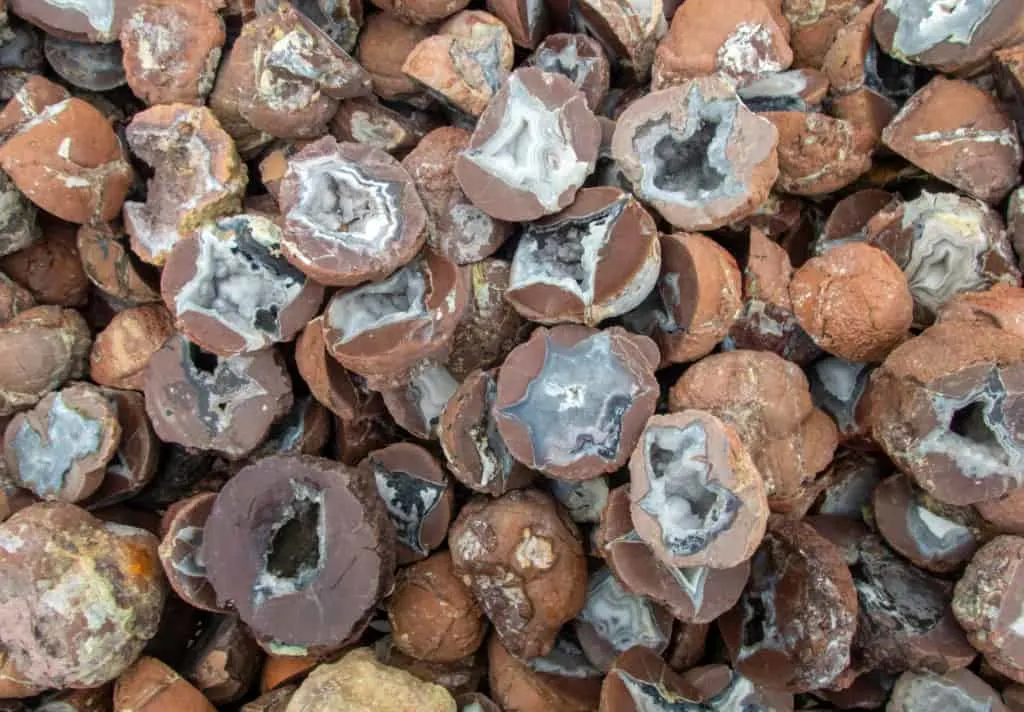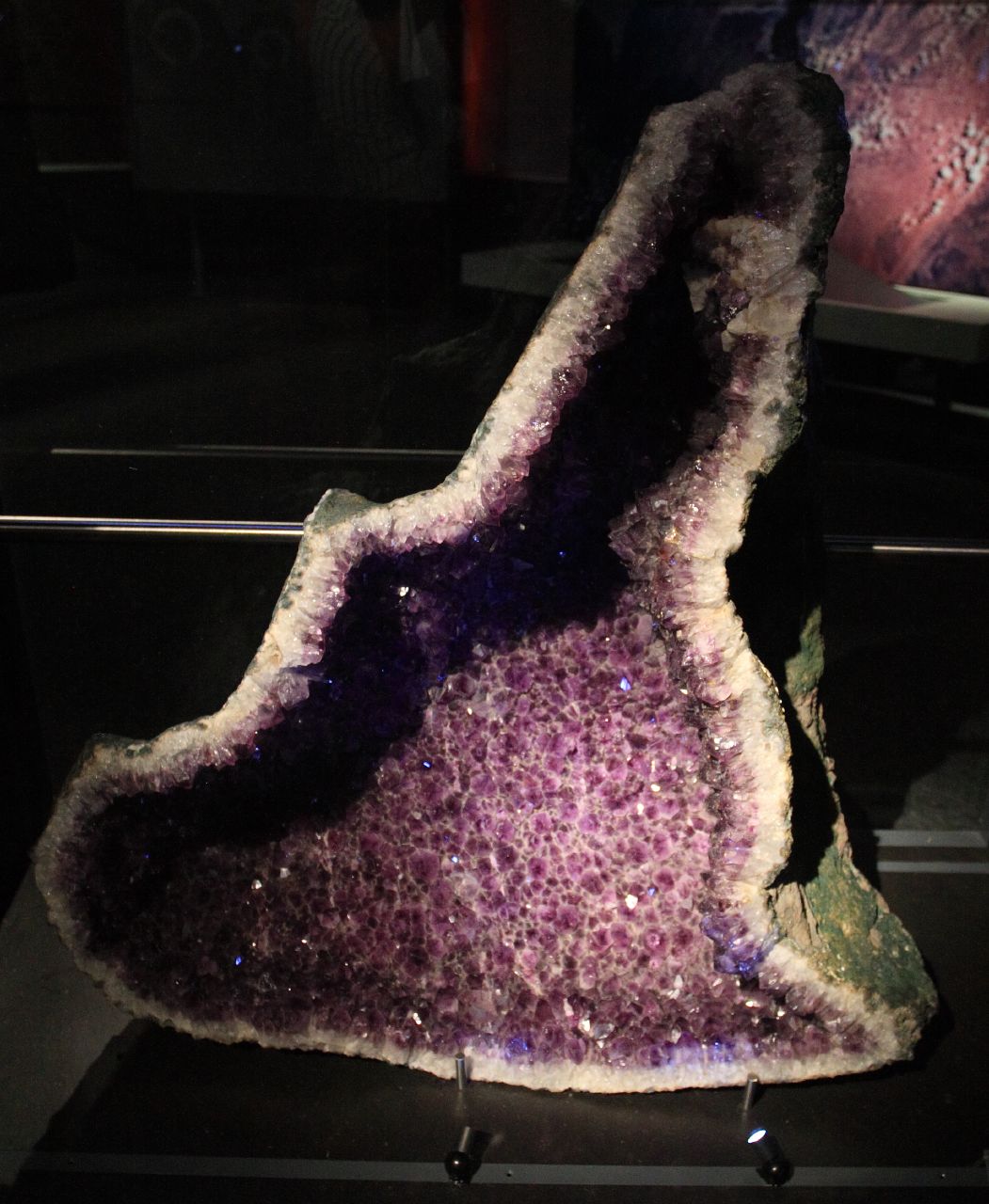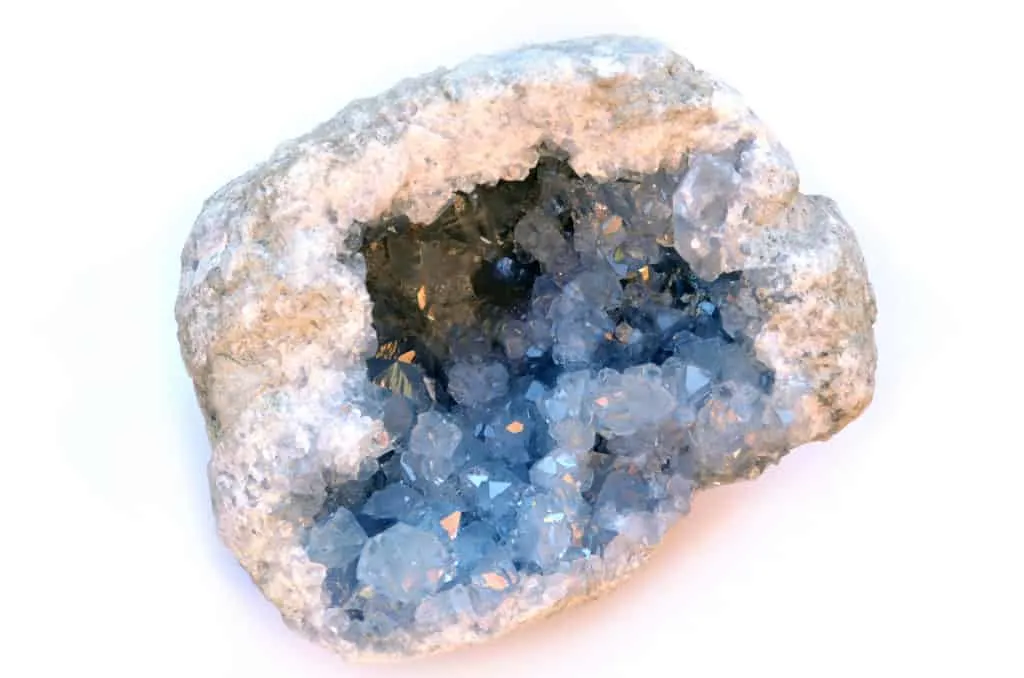As an Amazon Associate, I earn from qualifying purchases with no additional costs for you.
Geodes are stunning small geological structures. Outwardly, a geode resembles an ordinary stone yet conceals the captivating crystalline treasure. Unlike simple crystals, geodes exemplify diminutive natural cave systems – seemingly mundane exteriors sheltering resplendent interiors. Formed through prolonged mineral-rich water flows depositing silica layers on hollow gas cavities in volcanic rocks, diverse crystalline types compose the inner linings, from quartz to amethyst.
The most common crystals inside a geode are quartz and its purple variety, amethyst. Less common are calcite, aragonite, celestine. Rare hematite, magnetite, pyrite, millerite, baryte, and rhodochrosite crystals can also be found and are highly sought-after by professional mineral collectors.
Do you want to know how did the crystals get into the geode? Keep reading; you will be surprised at the similarities between bubbles in a glass of champagne and geode formation.

If you want to check out beautiful geode rocks, you can find them by clicking here (Amazon link).
What Types of Crystals are Found in Geodes
Geodes are a generous source of different types of crystals. Minerals in geodes can be found in other appearances: well-formed crystals with even facets that form beautiful scintillating druses and in the form of bands, layers, or crusts. The most common crystals in geodes are quartz, amethyst, celestite, calcite, and selenite.
Quartz Crystal
No doubt, the most common crystals found in geode are colorless quartz and amethyst (a vivid purple variety of quartz). Both are geodes found in crystallized lava and connected to volcano activity. Quartz geodes usually display a perfect scintillating druse of perfectly formed transparent crystals.
Amethyst Crystal
Amethyst geodes are often called “amygdules” due to their irregular, non-spherical shape. The largest amethyst amygdules, some spanning multiple meters in diameter, have been found in Brazil and Uruguay, specifically, the Rio Grande do Sul region.
These South American areas are world-renowned hotspots for ginormous amygdaloidal amethyst geodes of sublime popularity among collectors and interior designers alike.

Amethyst geodes are so popular that they are sometimes sold in an unopened state in a Break-your-own geodes kit (Amazon link) with a hammer. The person should feel him/herself as a mineral hunter and discover how beautiful a geode is with his/her hands.
Celestine Crystal

Another beautiful crystal found in geodes is Celestine. Its appealing light-blue color cannot leave you indifferent. Celestine is a strontium sulfate, so you will get a good-looking sample and an intriguing chemical composition.
Calcite Crystal
Well-formed calcite crystals can also be found in geodes. They look quite similar to transparent quartz; however, they have slightly different forms of facets, and calcite’s hardness is lower than quartz’s. Calcite looks nice in geodes and brings up feelings of an ice cave in your hands.
Selenite Crystal
Gypsum crystals can also be found inside a geode. They can occur together with quartz; however, you will easily separate one from another. Selenite tends to form elongated needle-like crystals with a gentle sheen luster.
The biggest geode in the world – The Pulpí Geode in Spain is composed of giant (2 meters long) crystals of selenite). The rugby ball-shaped geode occupies a space of 10.7m2 (8m long, 1.8m wide, 1.7m average high). It is the only place in the world to get inside a giant geode.
TIP: The value of a geode mostly depends on the worth of what is inside it. Check out the main factors of geode value in the article below:
The Value of Geodes: Are They Worth Anything?
Rare Crystals Found in Geode
There are a lot of other crystals and minerals you can find in a geode. They can be not-so-appealing perfectly-formed sparkling crystals discussed above and can be observed as layers, crusts, and grape-like botryoidal crystals.
But that’s not the reason to skip this paragraph because professional mineral collectors highly praise these rare crystals, which can reach thousands of dollars for geode.
Rare crystals found in geodes are hematite, magnetite, pyrite, chalcopyrite, millerite, baryte, rhodochrosite, jasper, agate, and chalcedony, aragonite.
Agate, Chalcedony, and Jasper
These cryptocrystalline varieties of quartz are found as colorful layers inside the geode. They produce intriguing patterns and can tell a lot about the history of geode formation.
Aragonite
Calcite and its structural variety, aragonite, can be found in the forms of crystals described in the previous paragraph and in the form of banding layers. Thin aragonite layers can change each other inwards, creating gentle, colorful stripes.
BTW: Do you want to know more about rock and mineral identification? The books listed below are the best ones you can find on the internet (Amazon links):
- Smithsonian Handbooks: Rocks & Minerals
- Gemstone & Crystal Properties (Quick Study Home)
- Ultimate Explorer Field Guide: Rocks and Minerals (National Geographic Kids)
Hematite and Magnetite
These two iron oxides are not as fancy as amethyst in geodes. However, they are highly praised by scientists and collectors as they can shed light on forming iron ore deposits and are commonly found during mineral exploration.
Pyrite and Chalcopyrite
Iron sulfide and iron-copper sulfide, or “fool’s gold,” look like real gold and can be an eye-catching treasure in your collection.
Millerite
This nickel sulfide occurs in thin acicular needle-like crystals resembling chrysanthemum flowers inside a geode. Millerite crystals are composed of nickel and sulfur.
Combining such substantial elements produces fragile and thin crystals of a gentle green color (rare for the crystal world). The specimen below is a goal of many crystal collectors.
Baryte and Rhodochrosite
These two crystals can be found together in a geode. The most exciting thing is that a geode is usually a hollow left after an ancient shell, replaced by iron oxides and hydroxides. So everything is perfect here. You will have rare minerals inside an extremely rare geode.
TIP: If you have ever encountered a mesmerizing geode with splendid color in a crystal shop, you may have wondered if that piece is dyed or natural. Find out the answer in the article below:
How to Tell if a Geode is Dyed: All You Need to Know
How do Geodes Form?
There are two types of geode formation processes.
The first one is gas bubbles or vesicle formation in basaltic lava during the uplift of magma from beneath the earth to the surface.
The physics of the process is the same as the immediate bubble formation in champagne after the bottle opening. The difference in pressure lets the gases in a dissolved state form vesicles.
Not all the bubbles can escape and when lava solidifies, bubbles stay inside the rock, providing a space for further crystal growth.
The second way is geode formation in sedimentary rocks. A geode can be formed in cavities left after fossil shells, branches, roots, and other organic materials decay, leaving a void for crystalline materials inside a geode.
Eventually, the bedrock that holds the geodes weathers and breaks down. If the geodes are made of highly resistant materials such as quartz, chalcedony, or jasper, they rest in irregular patterns at the surface.
TIP: Geodes and thundereggs may appear similar at first glance. That’s why a lot of misunderstanding occurs in their differentiation. Find out more in the article below:
The 7 Main Differences Between Geode and ThunderEgg
How do Crystals Grow in Geodes?
Crystals form inside a geode because of passing hydrothermal solutions or groundwater precipitation. When hydrothermal fluids enriched in elements necessary for crystal growth or groundwater reach the voids in the rocks, mineral starts to crystallize.
Depending on the composition of the solution, different minerals will grow. If the solution brings silicates, the layers of chalcedony or jasper will inlay the geode wall.
For example, silicon is essential for quartz and amethyst crystal formation, calcium and carbon are fundamental for calcite, and calcium and sulfate are crucial for gypsum crystal growth.
Free space inside the geode lets the minerals inside the bubble form perfect crystals without obstacles. Crystal growth occurs from the outer part of the geode towards the center.
Shifting in the chemical composition of the feeding solution will find its reflection in different colors of bands inside the geode.
In the end, the hollow interior of the geode is filled with inward-projecting crystals, new layers, or new generations of crystals growing on top of the old. And the whole growing process can last for millions of years.
TIP: You can find many geodes for sale on the Internet. But not all of them are real. Do you know how to distinguish the real from the fake? Read the article below and never make a mistake again:
What’s the Difference Between Real and Fake Geodes?
Conclusion
Geode is a perfect source of natural and perfectly-looking crystals. They can contain scintillating druses of quartz and amethyst, which are extremely popular all over the world, or they can hide a real mineral treasure for mineral collectors as milarite needle-like crystals of rhodochrosite and barite crystals inside an iron shell.
A lot of crystals can be found in a geode. We have discussed the most common 16 above.
They are quartz, amethyst, agate, chalcedony, jasper, calcite, aragonite, celestine, gypsum, hematite, magnetite, pyrite, chalcopyrite, millerite, baryte, rhodochrosite.
Geodes are essentially part of any mineral collection. They bear a druse of fine crystals and have an extremely interesting history of formation, which should be shared.
TIP: Geodes are mainly found near desert regions or areas with limestone deposits. Check out the best environments and locations in the USA in the article below:
Where to Find Geodes: 5 Best Environments & Locations (USA)
